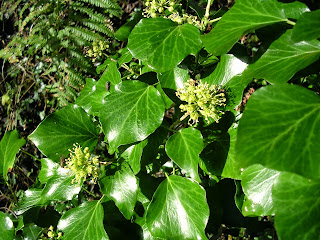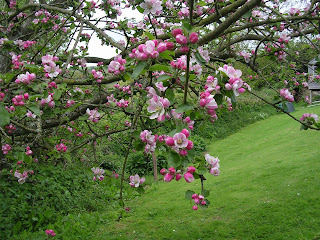Tuesday, 24 December 2013
Monday, 9 December 2013
Sunday, 8 December 2013
Sheep in the landscape
Keeping their distance from Dog:
Sheltering in the gullies from former
tin-mining on Dartmoor:
Keeping each other warm:
Resting under an old oak tree:
Friday, 6 December 2013
If I were a poet
As Frog and I perused the latest literature
from the Devon Wildlife Trust the other evening, Frog pointed out that, while DWT has 48 natures
reserves, none of them is in our part of the county. We live, I suppose, in an
intensively farmed area and so I have to find wild nature where I can – in an
ancient oak tree, an untamed bit of hedge, a corner of a field that has escaped
the plough. Maybe that is why these days I find my eyes being constantly drawn
upwards. The sky is still more or less as God intended it to be.
If I were a poet I would write about the
sky, and if I were an artist I would paint it. As I’m neither, I have to make do with photographs. And here are two I took this morning.
Monday, 2 December 2013
More happy birds
EIGHT blackbirds on the fallen Bramleys this morning. Word is getting out. I wish I could find a way to take a photograph without scaring them all away.
Tuesday, 26 November 2013
Happy birds
In the previous but one post I mentioned
leaving apples unpicked so that the birds can enjoy them. Well, the blackbirds are now feasting on the fallen Bramleys - I counted six at one time on Sunday - and numerous other birds
flitting backwards and forwards. If I can get close enough I’ll take a
photograph.
Friday, 22 November 2013
Sky
I am obsessed with the sky at the moment. Here are two pictures I took this afternoon while walking with the dog.
 | |||
| Spot the dog |
Saturday, 16 November 2013
Bramleys
Bramleys are wonderful trees. They produce
vast quantities of apples with little – or in our case, no – attention. Sadly,
our beloved Bramley blew over in the storm a couple of weeks ago (possibly due to lack of attention . . .).
Nevertheless, it is still alive, and now there
is a whole new batch of apples that I can reach.
However, I don’t need any more Bramleys. I’ve
given away two boxes and I have a utility room full of buckets of them. We eat them
every night – as either apple crumble or apple cake – and yesterday I made some chutney.
I think I shall leave the rest of the apples for the birds,
as my brother-in-law Peter does. We stayed with him in October a few years ago
and his Bramley tree was smothered in blackbirds. It was glorious.
Here is our Bramley in better days (May
2010).
We're wondering whether to prune all the trees around the Bramley (which caused it to develop too much on one side) and then haul it back up somehow. But I'm such a wuss about pruning (and weeding, and destructive-type gardening in general, as you may have gathered).
Wednesday, 6 November 2013
Storm damage
One of the many casualties of the storm last week. I'm glad I wasn't underneath when this branch fell. The poor tree looks very lopsided now.
Tuesday, 29 October 2013
Holly
Holly berries looking glorious in the sunshine on Sunday morning. I wonder if they've survived the storm.
There are a lot around this year - the result of the good summer, I would say, not the sign of a hard winter to come as others claim.
They never last till Christmas though, do they. I suppose the birds eat them. (And good luck to them.)
Wednesday, 23 October 2013
Ivy
 |
| Ivy flowers this morning |
Ivy is not a popular plant, at least not
with those who favour tidy gardens (unlike me). Wildlife however loves it.
Being evergreen, it provides shelter for birds in the winter, and they nest in
its dense foliage. It flowers now, providing nectar for insects when there aren’t many other blossoms
around, and fruits in late winter providing food for birds when there's nothing else.
The flowers smell rather sickly but they are always buzzing. My wildflower book says it is pollinated by wasps and flies although Nina (‘The Owl and the Pussycat’) says bees love it too. I shall have a good look next time I pass.
The fruit are a striking pale yellow and gladden human hearts at a bleak time of year.
 |
| Ivy fruit, seen in February |
Subscribe to:
Comments (Atom)


















